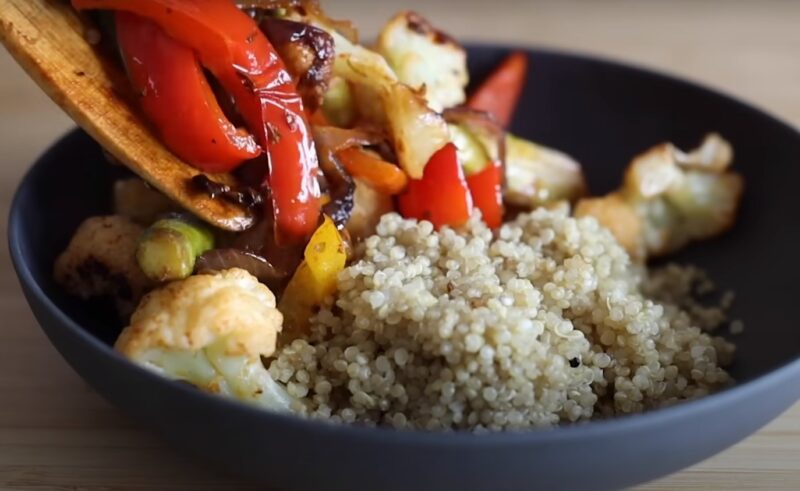Do you have trouble getting your family to eat healthy meals?
Do you worry that they are missing out on important nutrients because of their picky eating?
If you are tired of fighting with your kids over food, you are not alone!
In this article, you will learn why some people are more selective about what they eat and what are the health consequences of a limited diet.
You will also discover how to encourage your loved ones to try new foods and enjoy a balanced diet. (And yes, this applies to adults too!)
1. Taco Salad

Taco salad is a vibrant and customizable meal that can win over even the most selective eaters. Its beauty lies in the ability to tailor each component to individual tastes, ensuring everyone gets exactly what they like. From choosing their own toppings to adjusting the level of spice, it’s a fun and interactive way to encourage healthy eating.
Instructions and Ingredients
- Ingredients: Ground meat (beef, turkey, or chicken), taco seasoning, lettuce, tomatoes, cheese, black beans, corn, avocado, sour cream, and tortilla chips.
- Instructions: Cook the ground meat with taco seasoning. Assemble the salad by layering lettuce, cooked meat, and additional toppings as desired. Serve with a side of tortilla chips for added crunch.
2. Burger Bar with Rustic Sweet Potato Fries
A burger bar offers a hands-on dining experience that can cater to the whims of any picky eater. Accompanied by rustic sweet potato fries, it’s a meal that combines comfort with nutrition. The versatility in choosing their own burger toppings and the sweet, caramelized flavor of the fries make this meal a hit.
Instructions and Ingredients
- Ingredients: Ground beef or turkey, burger buns, lettuce, tomatoes, cheese, onions, pickles, ketchup, mustard, sweet potatoes, olive oil, salt, and pepper.
- Instructions: Form patties and grill to preferred doneness. Bake sweet potato fries tossed in olive oil and seasoning until crispy. Allow everyone to assemble their own burgers with their chosen toppings.
3. Coconut Chicken Tenders

Coconut chicken tenders are a delightful twist on a classic favorite, offering a crunchy exterior with a hint of sweetness. This dish is particularly appealing to children and adults alike, serving as a healthier alternative to traditional fried chicken.
Instructions and Ingredients
- Ingredients: Chicken tenderloins, shredded coconut, breadcrumbs, eggs, flour, salt, and pepper.
- Instructions: Coat chicken in flour, dip in beaten eggs, and then press into a mixture of breadcrumbs and shredded coconut. Bake until golden and crispy.
4. Chicken Teriyaki Bowls
Chicken teriyaki bowls are a flavorful and balanced meal, combining the savory taste of teriyaki chicken with the wholesomeness of rice and vegetables. It’s a versatile dish that allows for customization in vegetable choice, catering to the preferences of picky eaters.
Instructions and Ingredients
- Ingredients: Chicken breast, teriyaki sauce, rice, broccoli, carrots, bell peppers, and sesame seeds.
- Instructions: Sauté chicken in teriyaki sauce until cooked through. Serve over rice with steamed or stir-fried vegetables. Sprinkle with sesame seeds for garnish.
5. Hawaiian Meatballs with Roasted Broccoli

Hawaiian meatballs introduce a sweet and tangy flavor that can captivate the taste buds of picky eaters. Paired with roasted broccoli, this meal offers a delightful combination of flavors and textures, making it both nutritious and appealing.
Instructions and Ingredients
- Ingredients: Ground beef or turkey, breadcrumbs, egg, pineapple chunks, barbecue sauce, broccoli, olive oil, salt, and pepper.
- Instructions: Mix meat with breadcrumbs and egg, form into balls, and bake. Simmer meatballs in a mixture of barbecue sauce and pineapple chunks. Roast broccoli with olive oil and seasoning until crisp.
6. Crispy Drumsticks
Crispy drumsticks are a universally loved dish that can easily be made healthier by baking instead of frying. This meal is perfect for picky eaters who love finger foods, offering a satisfying crunch with every bite.
Instructions and Ingredients
- Ingredients: Chicken drumsticks, breadcrumbs, parmesan cheese, garlic powder, paprika, salt, and pepper.
- Instructions: Coat drumsticks in a mixture of breadcrumbs, parmesan, and spices. Bake until crispy and fully cooked.
7. Slow Cooker Steak Fajitas

Slow cooker steak fajitas are a fuss-free meal that packs a punch of flavor. The slow cooking process tenderizes the steak and melds the flavors beautifully, making it a hit with those who may usually shy away from tougher cuts of meat.
Instructions and Ingredients
- Ingredients: Sliced steak, bell peppers, onions, fajita seasoning, and tortillas.
- Instructions: Place steak, vegetables, and seasoning in a slow cooker. Cook on low for 6-8 hours. Serve with warm tortillas and desired toppings.
8. Apple Dippers
Apple dippers are a fun and healthy snack or dessert option that can entice picky eaters with their simplicity and sweetness. Served with a variety of dips, they offer a refreshing break from processed snacks.
Instructions and Ingredients
- Ingredients: Apples, peanut butter, yogurt, honey, and granola.
- Instructions: Slice apples into wedges. Serve with dips such as peanut butter, yogurt mixed with honey, or even a sprinkle of granola for crunch.
9. Blueberry Sausage

Blueberry sausage combines the savory flavor of sausage with the sweet burst of blueberries, creating a unique and enticing dish. This meal is an excellent way to introduce more fruit into a picky eater’s diet in an unexpected way.
Instructions and Ingredients
- Ingredients: Ground pork, fresh blueberries, maple syrup, sage, salt, and pepper.
- Instructions: Mix ground pork with blueberries, maple syrup, and spices. Form into patties and cook until golden and cooked through.
10. Egg Muffins
Egg muffins are a versatile and convenient breakfast option, perfect for on-the-go eating. They can be customized with various ingredients, making them an excellent choice for picky eaters who can choose their favorite add-ins.
Instructions and Ingredients
- Ingredients: Eggs, milk, cheese, and a choice of fillings such as spinach, tomatoes, onions, bell peppers, and cooked bacon or sausage.
- Instructions: Whisk eggs and milk together. Stir in cheese and chosen fillings. Pour into muffin tins and bake until set.
What Is Causing People to Be So Selective With Food?
Picky eating is a common challenge many parents face, often leaving them puzzled and concerned about their child’s nutritional intake. If you’re navigating the tricky waters of picky eating in your household, you’re not alone.
This phenomenon can vary greatly from one child to another, even within the same family, raising questions about its origins and best management practices.
Young Taste Buds

Our natural inclination towards sweet flavors and aversion to bitter ones is an evolutionary trait meant to protect us. This instinct is particularly strong in children, who are born with approximately three times as many taste buds as adults.
This heightened sensitivity can make the introduction of vegetables and other less sweet foods more challenging. Recognizing this, parents can adopt strategies that gradually introduce these flavors in a positive and patient manner.
Also, if you want to secure a healthy lunch for you kid every day, check out this list of healthiest everyday lunch recipes.
Fear of the Unknown
Neophobia, or the fear of the unknown, extends to food. Children, with their limited experiences, may be especially hesitant to try new foods, a reluctance that can be compounded by unfamiliar textures or appearances.
Overcoming this fear requires a gentle and consistent approach, encouraging exploration in a no-pressure environment.
Personality
Just as adults’ personalities influence their decisions and behaviors, children’s dispositions can affect their eating habits. A child’s inherent traits can make them more or less open to trying new foods, suggesting that a one-size-fits-all approach to addressing picky eating may not be effective.
Power Struggles

Between the ages of two and four, children are discovering their autonomy, including control over what they eat. This period often coincides with the emergence of picky eating behaviors.
The challenge for parents is to navigate this phase without escalating mealtime into a battleground, striving instead for a balance between guidance and freedom.
Consequences of a Limited Diet
The implications of picky eating extend beyond mealtime frustrations. Persistent picky eating can lead to nutrient deficiencies, affecting a child’s growth, brain development, and overall health.
Moreover, habits formed in childhood often carry into adulthood, potentially leading to long-term health issues and social anxieties around food. The family dynamic can also suffer, as persistent conflicts over food create stress and negative associations.
FAQs
Does ADHD cause picky eaters?
Some studies suggest that children with ADHD tend to be more selective about what they eat. This could be related to how they process sensory information, how their brain chemicals affect their appetite, or how they cope with emotions.
What not to say to a picky eater?
Avoid saying things that put pressure on the picky eater, such as “You have to finish your plate”, “No dessert until you eat this”, or “You’re missing out on something delicious”. These can make eating more stressful and unpleasant. Instead, be positive, patient, and supportive.
What food do picky eaters not eat?
Picky eaters may dislike foods that have strong or unusual tastes, smells, textures, or looks. Some examples are: mushrooms, pickles, peppers, tomatoes, spinach, seafood, coconut, mustard, olives, avocados, cottage cheese, Brussels sprouts, celery, cream cheese, spicy foods, sushi, blueberries, toast that’s too brown, peas, coleslaw, grits, raisins, refried beans, and anything sour.
What age are kids less picky?
Picky eating is a common phase that many kids go through from about age 2 to 6. It usually gets better as they grow older and become more willing to try new foods. However, some people may remain picky eaters into adulthood.
The Bottom Line
Picky eating is a complex problem that requires time and effort to solve, but knowing why it happens and using effective methods can make it easier to deal with.
By creating a supportive, calm, and steady environment around food, parents can help their children learn to enjoy a variety of foods and eat well.
